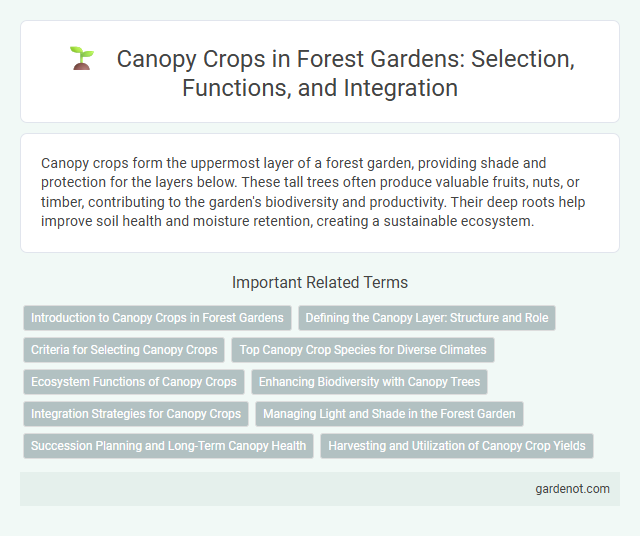Canopy crops form the uppermost layer of a forest garden, providing shade and protection for the layers below. These tall trees often produce valuable fruits, nuts, or timber, contributing to the garden's biodiversity and productivity. Their deep roots help improve soil health and moisture retention, creating a sustainable ecosystem.
Introduction to Canopy Crops in Forest Gardens
Canopy crops form the uppermost layer in forest gardens, playing a crucial role in maximizing sunlight capture and creating a microclimate that supports diverse plant layers below. Typical canopy species include fruit and nut trees such as chestnut, walnut, and apple, which provide essential yields while enhancing biodiversity. These trees not only produce valuable edible resources but also improve soil fertility and offer habitat for beneficial wildlife.
Defining the Canopy Layer: Structure and Role
The canopy crop in a forest garden forms the uppermost layer, consisting of tall fruit and nut trees that capture the majority of sunlight and provide shade. This structure plays a crucial role in creating a microclimate that protects lower layers from extreme weather, conserves soil moisture, and supports biodiversity. Its strategic position influences the growth and health of understory plants by regulating light exposure and nutrient cycling.
Criteria for Selecting Canopy Crops
Selecting canopy crops for a forest garden requires evaluating factors such as growth height, sunlight requirements, and compatibility with understory plants. Ideal canopy crops should provide adequate shade without excessively limiting light to lower layers, support biodiversity, and produce valuable yields like fruits, nuts, or timber. Resilience to local climate conditions, pest resistance, and root system behavior are critical criteria influencing long-term sustainability and ecosystem balance.
Top Canopy Crop Species for Diverse Climates
Top canopy crop species for diverse climates in forest gardens include durable trees such as mango (Mangifera indica), avocado (Persea americana), and jackfruit (Artocarpus heterophyllus), which provide substantial shade and fruit yield. These species exhibit adaptability across tropical, subtropical, and some temperate zones, enhancing biodiversity and microclimate regulation. Selection depends on local climate factors like temperature range, rainfall patterns, and soil type to optimize growth and sustainability.
Ecosystem Functions of Canopy Crops
Canopy crops in forest gardens play a crucial role in regulating microclimates by providing shade that reduces soil temperature and evaporation, thereby enhancing moisture retention and supporting understory plants. These tall, leafy crops contribute to carbon sequestration through substantial biomass accumulation, which helps mitigate climate change and improve air quality. The canopy layer also supports biodiversity by offering habitat and food resources for various pollinators, birds, and beneficial insects, fostering a balanced and resilient ecosystem.
Enhancing Biodiversity with Canopy Trees
Canopy crops in forest gardens play a crucial role in enhancing biodiversity by providing habitat and food sources for a wide range of wildlife, including birds, insects, and mammals. These tall, shade-providing trees improve microclimates and soil health, fostering diverse understory plant species and supporting complex ecological interactions. Integrating native canopy trees such as oaks, maples, and chestnuts increases ecosystem resilience and contributes to sustainable agroforestry systems.
Integration Strategies for Canopy Crops
Integrating canopy crops in a forest garden enhances biodiversity and maximizes vertical space by utilizing tall fruit or nut trees such as chestnuts, chestnut, and walnuts that provide shade and microclimate benefits. Strategic planting considers species compatibility, root depth variation, and successional growth to ensure nutrient cycling and pest control within the agroforestry system. Proper spatial arrangement improves light penetration and water retention, fostering resilience and productivity in multi-layered forest garden ecosystems.
Managing Light and Shade in the Forest Garden
Managing light and shade in a forest garden is essential for optimizing canopy crops such as nut trees, fruit trees, and timber species. Proper pruning techniques and strategic spacing allow maximum sunlight penetration to understory plants while preventing excessive shading that can stunt growth. Integrating diverse vertical layers ensures a balanced microclimate, enhancing photosynthesis and overall productivity of canopy crops.
Succession Planning and Long-Term Canopy Health
Succession planning in forest gardens ensures continuous canopy crop productivity by strategically integrating fast-growing species with slower-maturing, shade-tolerant trees. This approach maintains long-term canopy health by promoting biodiversity, nutrient cycling, and resilience against pests and diseases. Proper management of canopy layers supports soil stability and microclimate regulation, enhancing overall ecosystem sustainability.
Harvesting and Utilization of Canopy Crop Yields
Harvesting canopy crops in forest gardens involves timing the collection to maximize flavor and nutrient content, typically during peak ripeness seasons for fruits like mangoes, avocados, and nuts such as chestnuts and walnuts. Efficient utilization includes fresh consumption, drying, processing into jams, oils, or flours, and storing seeds for future planting to maintain biodiversity. Integrating canopy crop yields into local markets and home food systems enhances food security and promotes sustainable agroforestry practices.
Canopy crop Infographic

 gardenot.com
gardenot.com